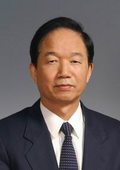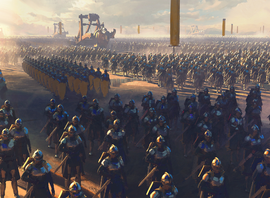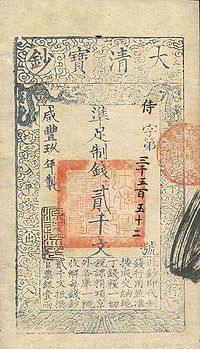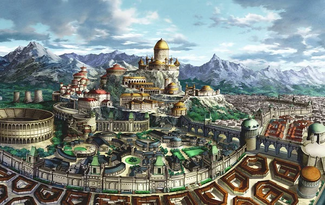Shinkei
This article is incomplete because it is pending further input from participants, or it is a work-in-progress by one author. Please comment on this article's talk page to share your input, comments and questions. Note: To contribute to this article, you may need to seek help from the author(s) of this page. |
神経組織 スパークリアの研究と保存のため新慶組織 (Nihongo) Shinkei Organization of Shinkei Organization of Shinkei for The Research and Preservation of Sparkalia | |
|---|---|
| Motto: 「敬天愛人」 "Keitenaijin" "Revere the heaven, love the people." | |
| Anthem: 「凱旋行進曲」 "Gaisen Kōshinkyoku" "Triumphal March" | |
| Administrative | Control Site A |
| Other languages | Nihongo |
| Type | Governmental geopolitical organization with a junta controlling federal puppet states |
| Member states | 2 representative states
|
| Leaders | |
• Secretary General of Organization Shinkei | Hayato Uwadaira |
• Commander of The Shinkei Regional Control Army | Yutaka Yamase |
• Head Researcher of The Shinkei Research Group | Mayumi Nikkuni |
• Chairperson of The Civilian Control and Management Group | Jirō Rai |
• Representative of The Shinkei Project | Minoru Saitō |
| Legislature | Shinkei Head Committee |
| Establishment | |
• Project Shinkei | 8 February 1532 |
• First settlement established | 11 March 1532 |
• Operation Zenshō | 10 May 1534 |
• Meikakuna Michi Campaign | 11 January 1545 |
• Treaty of The Ten Kingdoms | 29 March 1547 |
• Shinkei Declaration | 1 May 1547 |
| Population | |
• 1610 estimate | 1,671,781 179,059a 1,492,722b |
| GDP (PPP) | 1610 estimate |
• Total | $260.9 billion |
• Per capita | $156,061 |
| GDP (nominal) | 1609 estimate |
• Total | $90.6 billion |
• Per capita | $54,190 |
a Numbers of researchers and military personnel of the Nihonjin forces. b Residents of Jūmin-ryōiki Island. | |
The Organization of Shinkei (OS, Nihongo: 神経組織), officially the Organization of Shinkei for The Research and Preservation of Sparkalia (OSTRPS, Nihongo: スパークリアの研究と保存のため新慶組織), is a special governmental organization established by the Nihonjin as a research organization. The organization was created following the establishment of the Shinkei Declaration and the Treaty of The Ten Kingdoms. The OS was founded under the vision that the head of the organization would preserve, research and develop the realm Sparkalia with the help of science and technology.
History
Project Shinkei
The Nihonjin, in the homeworld, is a powerhouse militarily, economically, and technologically. The Nihonjin developed one of the strongest fusion power in the homeworld, resulting in advanced intergalatic space travel. The Nihonjin discovered the Sparkling realm, resulting in a temporary base of operation in 1533.
Following the discovery of Sparkalia, the Nihonjin were the later generations to arrive in Sparkalia, with the earliest sources pinpointing the first contact that happened in 1531. The first group of Nihonjin who arrived in Sparkalia was military personnel, researchers, and Scouters. The group worked under the "Nihonjin Expedition Army" as part of "Project Shinkei". The first group consisted of 10,000 personnel, which was followed by the second group with 20,000 more personnel. Both the expedition groups arrived on what is now known as Southeast Pythia, with the first group landing on the shore of the continent.
Project Shinkei and the Nihonjin Expedition Army were under the direct control of General Makoto Iji, a general of the Nihonjin Ground Force back in the homeworld. Project Shinkei (計画神経, Keikaku Shinkei, lit. Project Nerve) aimed to find a new settlement within the Sparkling realm, the first settlement later developed into Control Site A. Project Shinkei also consist of gathering samples of the ecosystem in the realm as well as interacting with locals. Project Shinkei was considered a success by the Nihonjin and their affiliates.
Project Shinkei was followed by Operation Zenshō (前哨作戦, Zenshō Sakusen, lit. Operation Outpost) after the first settlement was established and the second expedition group arrived. Operation Zenshō greatly expanded the first settlement and created a second settlement, "Outpost A", a port city held by the Nihonjin Expedition Army's navy. During the five years of the operation, the operational areas of the project greatly expanded and control of the Nihonjin forces began to be distributed between the military, the research group, and the civilian settlers.
Expansions and the colony of Masaqui
During Operation Zenshō, the Nihonjin navy made contact with local fishermen who instructed the force on a massive island east of Outpost A. Maintaining the momentum of the same expansion operation, the Nihonjin forces set sail with a force of 12,000 personnel and set foot on the beaches of Kingdom of Leiden. The Kingdom of Leiden was one of three human kingdoms on Jūmin-ryōiki Island and the first to come in contact with the Nihonjin forces.
Despite being in different worlds, the Nihonjin would introduce many new items to Leiden, most importantly the creation of the firearm. Initiating direct commercial and cultural exchange between Leiden and the Nihonjin forces, the first map made of the island was represented in 1538 by the research group.
In 1539, King Vaz Bartolomeu was forced to guarantee a little land in the small fishing village of "Masaqui" to the Nihonjin after being unable to repay for weapons and inventions. The Nihonjin use the land to receive more information on the island as well as the knowledge held by the inhabitants of the island. By 1541, Masaqui had over four hundred houses, and some of the Nihonjin settlers had gotten married to the locals. The Nihonjin forces came to realize that if they understood the language they would achieve more influence over the island. Nihonjin such as Takehiko Yamada wrote a series of dictionaries. Thus Nihonjin became one of the first languages from a different world to have such a dictionary when it was published in 1543.
On Jūmin-ryōiki Island, there were ten kingdoms that were constantly at war with each other. With the arrival of the Nihonjin, a coalition of eight kingdoms and dependent states was formed against them. But the Kingdom of Leiden had fallen into debt and became a puppet state for the Nihonjin following the Treaty of Masaqui. The Nihonjin began to militarize the kingdom with weapons from the Nihonjin forces for a planned military campaign against the coalition.
War of The Thousand Flowers
With the Kingdom of Leiden as a foothold on the island, the Nihonjin forces, consisting of the ground force, the navy, the air force, and the special force, began the Meikakuna Michi Campaign. The Meikakuna Michi Campaign (明確な道運動, Meikakuna Michi Undō lit. Clear Path Campaign) was a military campaign launched by the Nihonjin combined forces to extend the operative areas for the Nihonjin, as well as asserting more control over the island.
The war was considered an overwhelming success for the Nihonjin forces, with better military tactics, more high-tech weapons, and the application of hybrid weapons. The Nihonjin took over half of the island within a year while suppressing insurgencies and displacing hamlets built by the forces. The war was called a "one-sided war" due to the fact the Nihonjin forces and allies suffered only 8,000 troops while the Coalition's forces suffered ten times as much.
Near the end of the war, the Nihonjin forces began testing hybrid weapons, making them one of the first military forces to apply hybrid weapons in military operations in Sparkalia. As soon as the weapons saw their first usage, the Empire of Dragonica Legium, the last standing Coalition force, surrendered to the Nihonjin, ending the war altogether.
After the war, the Treaty of The Ten Kingdoms was signed, forcing all ten kingdoms, including Leiden, to be under full administration of the Nihonjin forces. The treaty also established the Federation of The Ten Kingdoms, a federal political entity with the ten kingdoms being its states. The treaty was followed by the Shinkei Declaration, the declaration solidified the Nihonjin power over the island and established the modern structure of the Shinkei Organization.
Stablization, assimilation and contemporary Shinkei
After the war ended, the Organization began a series of policies that stabilized the island and helped the Organization to assert control over the newly established Federation of The Ten Kingdoms. These policies include the replacement of the kingdoms' armies and renaming and redistributing lands between the kingdoms. To prevent future armed rebellion, combat weapons, firearms, and magical pieces, owned by the kingdoms' forces were confiscated and heavily regulated.
To reinforce the civil and military control over the kingdoms, the Organization established civil armies, paramilitaries with Nihonjin leaderships, aiming to control the population of the kingdoms. The Federal Ten Kingdoms' Armies were also established as a single military entity, overseeing the military actions of the kingdoms.
After stabilizing the island, the Organization implements reforms that effectively assimilate the populace on the island into Nihonjin culture. The Organization promoted the Nihongo language and the Liedish language, with the latter being promoted as a lingua franca. The Organization also established a name-changing policy, pressuring the populace to adopt a Nihonjin second name. Despite being a voluntary policy but the people who did not change their names were severely disadvantaged.
The Organization introduced a free public education system modeled after the Nihonjin school system in the homeworld, with a pyramidal hierarchy of elementary, middle, and high schools. It was one of the first free public education systems in Sparkalia. The public curriculum, which still exists to this day, is taught by native educators under a hybrid system focused on assimilating natives into Nihonjin ideologies while emphasizing their native cultural education. The Organization holds complete control over the material used in the system, prompting the usage of gaslighting and indotricnation of later generations into believing that the Organization was the force that established peace on the island and was a close ally to the people.
Throughout the years, the Organization is led by the Nihonjin only, with the current de facto Head of State being the Secretary General of the Organization, Hayato Uwadaira, and the Head of Government being the Commander of The Shinkei Regional Control Army, Yutaka Yamase. The Organization had orchestrated a military coup and is holding a military occupation on the Jūmin-ryōiki Island since 1589.
Politics
The Organization has two representative states, the core territories, owned entirely by the Organization and the Nihonjin, and the Federation of The Ten Kingdoms.
According to the Shinkei Declaration, the Organization of Shinkei, officially the Organization of Shinkei for The Research and Preservation of Sparkalia, "is a geopolitical governmental organization led by Nihonjin people and ruled by the people of Sparkalia" and the institutions of the organization "aim to protect, preserve and research the development of societal and cultural changes of Sparkalia, based on the alliance of the Organization and the people." The Organization is one of Sparkalia's only geopolitical entities governed by a force outside the realm. The Shinkei Organization's structural government has been variously described as centralist and kratocracy, but also as authoritarian and corporatist. The Organization is often described as an authoritarian surveillance state and a dictatorship.
The Federation of The Ten Kingdoms, according to the Shinkei Declaration, "is a dependent territory of the Organization. The Federation operates as a political entity, representing the ten federated states (the ten kingdoms of Jūmin-ryōiki Island). The Federation is under the leadership of the Nihonjin with the support of natives and is elected by the people of the kingdoms." The Federation is considered a puppet state of the Organization, with all ten kingdom states being under some kind of control by the Organization.
Leadership
The main body of the Shinkei Declaration declares that "the defining feature of Shinkei ideologies is the leadership of the Shinkei Organization and its Nihonjin government." The Declaration constitutionalized the de facto no-party state status of the Organization, wherein the Organization holds ultimate power and authority over state and government. While the Federation is in charge by native-elected leaders, under the vision of the Organization. The current Secretary-General is Hayato Uwadaira, who took office on 15 November 1602. There is no sign of election in the Organization, as the Organization is considered to be a Despotism.
Since both the Organization and the Federation promote according to seniority, it is possible to discern distinct generations of Shinkei leadership. In official discourse, each group of leadership is identified with a distinct extension of the ideological development of the Organization.
| Generation | Leader | Start | End | Theory |
|---|---|---|---|---|
| First | Susumu Katō | 1532 | 1550 | Nihon Gunkoku Shugi |
| Kabuto Ichizo | 1550 | 1561 | Susumu's Great General Theory | |
| Second | Etsusaburo Shiina | 1561 | 1573 | National Construction |
| Third | Naoya Yamazaki | 1573 | 1602 | Reform Cabinet Strategy |
| Fourth | Hayato Uwadaira | 1602 | Chiheisen o Hirogeru |
Government
Shinkei is a no-party state led entirely by the Organization of Shinkei (OS). The President and Secretary General, Hayato Uwadaira, is the titular head of state, elected by the Shinkei Core Headquarters. The Commander, Yutaka Yamase, is the head of government, presiding over the Shinkei Head Council composed of vice commanders and the heads of ministries and commissions. The incumbent leader is Yutaka Yamase, who is also the Vice Secretary General of the Shinkei Organization and the Chairman of the Central Military Commission, making him Shinkei's supreme leader. The incumbent secretary general is Hayato Uwadaira, who is also a senior member of the OS's Shinkei Control Committee, the Organization's de facto top decision-making body.
The Federation of The Ten Kingdoms is administrated by the Chamber of Jūmin-ryōiki, the highest state organ of the Federation, with control over the constitution crafted by the Organization and basic laws, as well as over the election and supervision of officials of other government organs of the kingdoms. The Chamber reports directly to the Shinkei Control Committee, which has full reign over the entire Chamber. The SCC both has a strong presence and strict control over the Chamber. The Chamber is used just to rubber-stamp decisions issued by the pro-Shinkei regimes in the ten kingdoms.
Military
Shinkei Regional Control Army
The Shinkei Regional Control Army (神経地方統制軍, Shinkei Chihō Tōsei-gun) is the principal military force of the Organization. The SRCA consists of five service branches: the Ground Force, Navy, Air Force, Expeditionary Force, and Special Strategic Force. It is under the leadership of the Central Military Commission (CMC), with its chairman as commander-in-chief.
The SRCA traces its origins to the Nihonjin Expeditionary Army (日本人海外派遣軍, Nihonjin Kaigai Haken-gun), a paramilitary force under the Shinkei Project, deployed with the first group of Nihonjin explorers to secured the safety and served as a primary military force for the group. The NEA then established the SRCA as an alternative to the Expedition Army, recruiting second generations Nihonjin and pro-Shinkei natives.
The SRCA is one of the smallest armies in the realm but one of the most advanced and powerful in terms of technology and with significant regional defense and power projection capabilities. The Special Strategic Force of the SRCA is also one of the first military forces to apply magic with technology in the realm of Sparkalia.
The SRCA follows the principle of the Organization's military ideologies of National Defence Diplomacy (国防外交, Kokubō Gaikō) under the doctrine of "unsinkable carrier fleets" (不沈空母艦隊, Fuchin Kūbo Kantai). In times of military emergency, the Organization's Militia act as a reserve and support element for the SRCA.
Federal Ten Kingdoms' Armies
The Federal Ten Kingdoms' Armies (連邦十王国軍, Renpō Jū Ōkoku-gun) is the combined military force of the Federation of The Ten Kingdoms, being formed from military personnel of the kingdoms' separate armies. The force acts as both a military policing force and standing army for the Federation.
The force, commonly called the Federal Armies, was established shortly after the War of The Thousand Flowers. Treaty of The Ten Kingdoms called for the total disbanding of the Coalition's forces, replacing them with the early Regional Safety Force (地域安全隊, Chiiki Anzen-tai). The Regional Safety Force was a lightly armed police force, under the leadership and training of the Nihonjin Expeditionary Army.
The Federal Armies is numerically superior to the SRCA, but it is strategically and technologically less advanced than the SRCA. The Federal Armies operates under the guidance of the SRCA and the leadership of the Central Military Commission.
The Federal Armies' purpose is to provide security on the Jūmin-ryōiki Island, but its true intent is to be a neocolonial army at the Organization's disposal. The Federal Armies had been involved in military operations for the Organization, one of which is the ongoing military occupation in Dragonica Legium.
Economy
The economy of Shinkei is based around natural economy with the Shin yen, a promissory paper note originated from the Nihonjin yen back in the homeland, as a tool for allocating resources between the Organization and the Federation. Despite just being a tool to allocate resources, the Shin yen has fixed exchange rates with certain resources on Jūmin-ryōiki Island. According to the Strategy Development, Supervision, and Management Bureau, 1000 Shin yen is equal to 1000 cooper coins, 100 silver pieces, or 10 gold pieces, all of which must be minted by the Organization-approved banks.
The Organization of Shinkei operates a planned economy, controlled strictly by the Strategy Development, Supervision, and Management Bureau. With little communication and trade outside the monitored borders, the Organization successfully developed a powerful regional economy with plentiful natural resources from intensive mining within and outside the borders. The Organization had been planning to transition the economy from a planned into a mixed economy when further communication is created with other nations. Meanwhile, the Federation of The Ten Kingdoms operates an informal economy and an autarky. Due to all of the preservation states in the Federation still operating the feudal system, their economies are still limited to small communities, towns, and cities. Using the limitations, the Organization could supervise and control the markets within the Federation, creating a power dynamic with the Organization holding absolute control over the Federation's market and trading.
The economy of the Organization specializes in producing electronics, communications, and information technology products, petroleum refining for military vehicles, chemicals, iron and steel, machinery, vehicles, consumer products, and pharmaceuticals. All of the production goes into the possession of the Organization before being redistributed among the Nihonjins and the Federation's citizens. The Federation mainly focused on the agricultural fields, outputting a large variety of products, particularly rice, wheat, corn, vegetables, fruit, tea, pigs, poultry, beef, milk, and fish.
The Organization had been developing the Federation and aiming to industrialize it by the end of the 17th Century fully. The former President and Secretary of the Organization, Masanobu Tsuji, approved Decree 301 (法令301), or the Industrialization And Development Plan (工業化開発計画), in 1576 and kickstarted the first industrialization process on Jūmin-ryōiki Island. According to Shinkei-kept records, the Organization-held territories are fully industrialized, compared to around 5% industrialized on Jūmin-ryōiki.
Science and technology
The Organization is one of the leading nations in the Sparkalia realm in technological research and one of the few nations to develop hybrid weapons. Science and technology are seen as vital for achieving the Organization's military and political goals and are held as a source of the Organization's foundation to a degree sometimes described as "techno-militarism". The Organization's scientific aims are to research magical properties and apply technological advantages to the magic found in the realm. The Organization and its scientific fields are also described to be a "cyberocracy" due to its heavy usage of information to run the Organization and the Federation.
The leading personnel in the scientifical, technological, and magical development is the Shinkei Research Group, a separate political entity of the Organization. The department, operated by 15,000 staff, develops human resources, including the introduction of intellectual planning, organizing international scientific and technological cooperation, and strengthening Shinkei's innovation capabilities in international scientific research. The department is currently led by Head Researcher Mayumi Nikkuni, the former director of the SRCA Special Forces.
The Shinkei Research Group is also making rapid advances in areas such as infrastructure, high-tech manufacturing, academic publishing, the study of magic, and geographical studies of Sparkalia. The Group's main focus is on technological development alongside magic and technology hybrid research.
The Organization's Decree 887 (法令887), or Strategic Technology and Social Development Plan (戦略的技術と社会開発計画), is one of the Shinkei Research Group's programs, funded and administered by the Organization, intended to stimulate the development of advanced technologies in a wide range of fields for the purpose of rendering the Organization independent of the required obligations for outside helps. The program used the pre-existed knowledge from the natives and assisted the Group to reap success in many fields.















